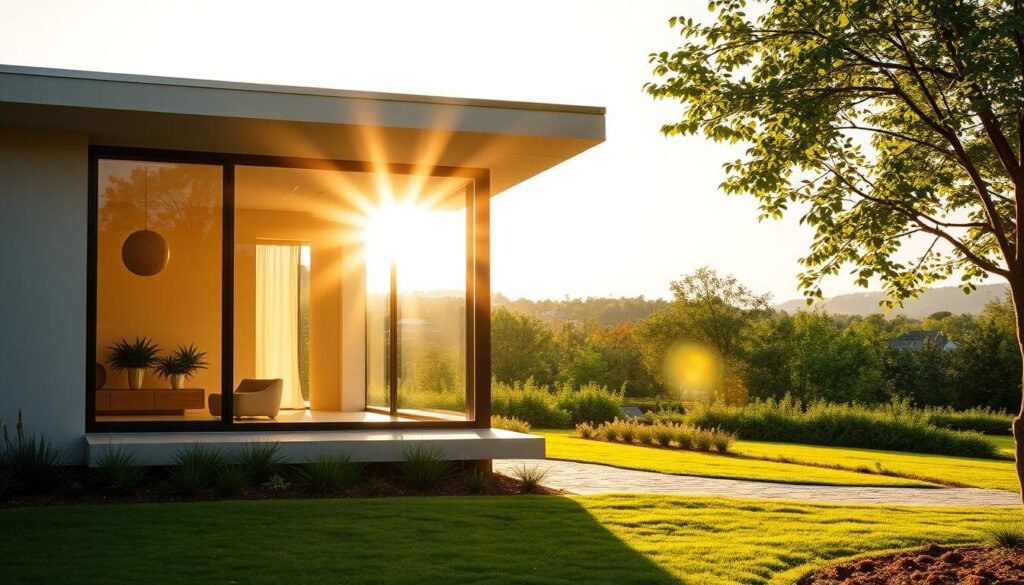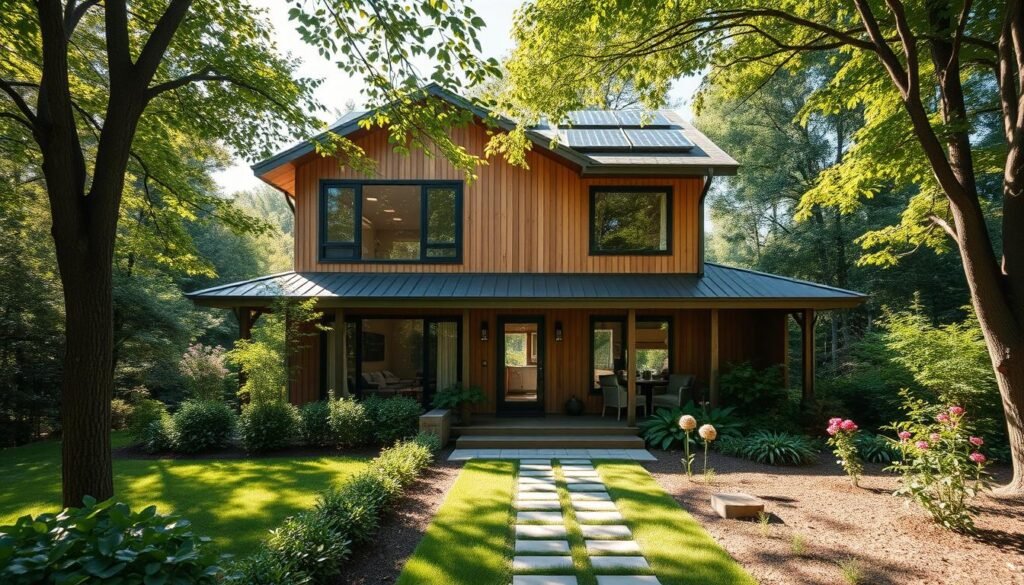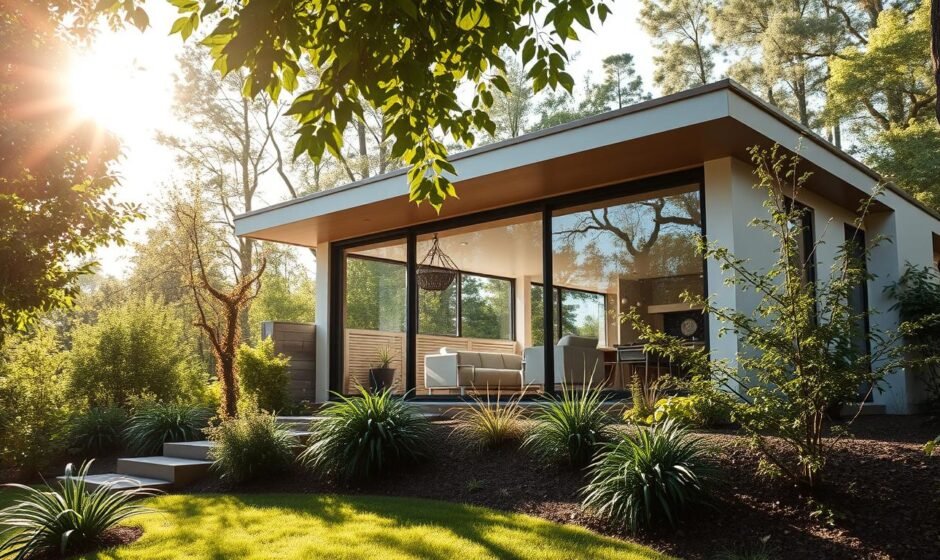Thinking of making your home more energy-efficient? Passive solar design could be the answer. It uses natural sunlight and heat to cut down energy use. This method is not only eco-friendly but also saves you money on bills.
In the UK, heating is a big source of carbon emissions. Passive solar design can make a big difference. It uses sunlight and heat to warm your home, reducing the need for mechanical heating. This is a smart choice for both new homes and renovations.
Key Takeaways
- Passive solar design can help you save money on your energy bills
- This approach to sustainable architecture can reduce your carbon footprint
- Passive solar design can be used in new builds and renovations
- It can help alleviate fuel poverty, specially in social housing
- Long-term energy bill savings can outweigh initial investments in passive solar design
- Passive solar design can improve indoor comfort and air quality
Understanding Passive Solar Design
Passive solar design uses natural sunlight and heat to warm your home. This reduces the need for mechanical heating. It’s a big part of renewable energy integration, aiming to cut down on non-renewable energy use. By using green building design principles, you can make your home more sustainable. This not only lowers your carbon footprint but also improves your life quality.
A well-designed passive solar home offers many benefits. It uses less energy, lowers your bills, and makes your home more comfortable. Key elements include thermal mass materials, insulation, and airtight construction. Knowing how these work together helps you make smart choices for your home.
- Reduced energy consumption and lower energy bills
- Improved indoor comfort and air quality
- Enhanced natural light and reduced need for artificial lighting
- Increased property value and higher resale value
By adopting renewable energy integration and green building design, you can build a sustainable, comfortable, and energy-efficient home. As you learn more about passive solar design, you’ll see how it can be customized for your needs and climate. It offers a unique and effective way to make your home special.
Benefits of Energy Efficiency in Your Home
Using thermal mass strategies and solar orientation makes your home more energy-efficient. This approach saves you money on energy bills. It also makes your home more comfortable and helps the environment.
Here are some main advantages of energy-efficient homes:
- Lower energy bills: Homes with passive solar design can save up to 30-50% on energy costs.
- Improved indoor comfort: These homes are 20-30% more comfortable, keeping temperatures steady.
- Reduced environmental impact: They can cut greenhouse gas emissions by 1-2 tons a year for each household.
By applying thermal mass strategies and solar orientation, you can make your home energy-smart. It will be comfortable and eco-friendly.
How to Evaluate Your Home for Solar Design
To check if your home is ready for solar design, look at a few key things. These include the site and location, your energy needs, and the local climate. Natural light is very important here. It helps make your home more energy-efficient by reducing the need for artificial light.
Start by looking at your home’s site and location. Think about how the sun hits your home during the day. This helps you see where you can use natural light best. Tools like sun path diagrams can show you the sun’s path and help pick the best spots for windows.
Next, figure out your energy needs. Look at how much energy you use now and where you can save. Energy audits can help you find ways to use less energy. By using natural light and considering your climate, you can make your home more energy-efficient and cut down on carbon emissions.
Key Components of Passive Solar Design
Creating a green home design means using passive solar design for energy efficiency. This method plans your home to use natural sunlight and heat. It cuts down the need for heating and cooling systems.
Several important parts are needed for this. These include:
- South-facing windows and glazing to capture natural sunlight and heat
- Thermal mass materials to absorb and release heat
- Insulation and airtightness to minimize heat loss and maintain a comfortable indoor temperature
These elements help make your home energy-efficient, comfortable, and sustainable. 
| Component | Benefits |
|---|---|
| South-facing windows | Maximizes natural sunlight and heat gain |
| Thermal mass materials | Absorbs and releases heat, maintaining a comfortable indoor temperature |
| Insulation and airtightness | Minimizes heat loss and reduces energy consumption |
Understanding and using these key parts of passive solar design for energy efficiency helps. You can make a green home design that’s sustainable and comfy. It also cuts down energy use and lowers bills.
Designing for Natural Light
Designing for natural light is key in sustainable architecture. It helps reduce the need for artificial lighting. This approach makes your home more energy-efficient. Natural light boosts mood and productivity too.
To get the most daylight, think about your building’s orientation and window placement. South-facing windows are best for natural light. Overhangs and shading control the light entering your home. Using materials like concrete or brick helps manage heat, cutting down on heating and cooling needs.
Adding natural ventilation to your design is also smart. It lowers the need for air conditioning and heating. This makes your home more comfortable and healthy. Strategies like operable windows, clerestory windows, and solar chimneys help achieve this.
By using these strategies, you make your home more sustainable and energy-efficient. It not only reduces environmental impact but also improves your well-being.
Choosing the Right Materials
When designing a passive solar home, picking the right materials is key. You need materials that cut down energy use and boost comfort. Thermal mass strategies are vital here, as they help control indoor temperatures. Using materials like concrete or stone can lessen the need for heating and cooling.
Solar orientation is also critical. Placing windows and openings wisely lets in more natural light and heat. South-facing windows, for example, can catch up to 50% more sunlight in winter. To avoid too much heat, use reflective and absorptive surfaces to manage heat gain.
When picking materials for passive solar design, consider these points:
- Sustainability: Choose materials that are good for the environment and have a low carbon footprint.
- Energy efficiency: Opt for materials that cut down energy use, like insulation and thermal mass materials.
- Comfort: Pick materials that keep the indoor temperature comfortable, such as those with high thermal mass.
By carefully choosing materials and using thermal mass strategies and solar orientation, you can build a cozy and green home. This home will use less energy and be better for the planet.
Cost Considerations and Savings
Implementing green building design and energy-efficient buildings raises the question of cost. You might wonder if the initial investment is worth the long-term savings. The good news is that passive solar design can be cost-effective. Studies show that Passivhaus-related building costs increase by less than 8% due to reduced heating needs and economies of scale.
In fact, some Passivhaus school projects have achieved the standard without extra costs. Home buyers are also willing to pay almost 10% more for energy-efficient properties. Careful planning is key to minimizing costs, as it can design out up to 60% of any cost premium for Passivhaus.
Initial Investment vs Long-Term Savings
The initial investment for passive solar design may seem daunting. But the long-term savings are significant. By reducing reliance on traditional heating sources, you can lower energy costs. In areas with high solar exposure, households can see drastic energy cost reductions, making it a worthwhile investment.
Financial Incentives and Grants
There are financial incentives and grants to help offset the initial investment. The UK government offers various schemes to encourage energy-efficient buildings. By taking advantage of these incentives, you can reduce upfront costs and make passive solar design more accessible.
Return on Investment for Passive Solar Design
The return on investment for passive solar design is significant. You can save on energy bills and increase your property’s value. Investing in green building design and energy-efficient buildings offers a sustainable and cost-effective solution for your home. Here are some key benefits:
- Reduced energy costs
- Increased property value
- Lower maintenance costs
- Improved indoor comfort
Understanding the cost considerations and savings of passive solar design helps you make an informed decision. With careful planning and the right incentives, you can create a sustainable and cost-effective solution. This benefits both you and the environment.
Implementing Passive Solar Design in Renovations
Renovating your home can make it more energy efficient and cut down on carbon emissions. By using natural lighting and green home design, you can make your home more sustainable and cozy.
Adding passive solar design to an existing home can be tough but rewarding. Finding the right materials and techniques for your climate and budget can be hard. But, with expert help, you can save a lot of energy.
Retrofitting Existing Homes
To start, follow these steps:
- Check your home’s energy use and find ways to improve it
- Get advice from a pro to find the best passive solar design for your home and area
- Choose energy-saving materials and tech, like insulation and double-glazed windows
By adding natural lighting and green home design to your renovation, you’ll use less energy. This makes your home healthier and more eco-friendly. Working with experts ensures your renovation goes smoothly and efficiently.

With the right strategy and help from experts, you can turn your home into a cozy, energy-saving, and eco-friendly space. This benefits you and the planet.
| Passive Solar Design Element | Energy Savings |
|---|---|
| South-facing windows | Up to 50% reduction in heating costs |
| Thermal mass materials | Up to 20% increase in overall home energy efficiency |
| Insulation improvements | Up to 30% reduction in energy consumption |
Real-Life Examples of Successful Passive Solar Homes
Thinking about using passive solar design in your home? Looking at real-life examples can be very helpful. In the UK, there are many inspiring projects that show how well passive solar design works. They show how it can cut down energy use and make homes more sustainable.
Inspirational UK Case Studies
The Wallingford Passive Solar House is a great example. It’s a big house, built on 1.3 acres, covering 4,500 square feet. It proves that even big homes can use passive solar design well. Another example is the 10 Star Home. It has a five-kilowatt solar panel on its roof. This helps it not need mechanical heating or cooling, thanks to passive solar design.
Lessons Learned from Real Homes
These examples teach us important lessons. They show how careful planning and design are key. They also highlight the importance of considering your local climate and energy needs. By following these tips, you can make a home that’s good for the planet and saves energy. It will also be a comfortable and healthy place to live.
By using passive solar design, you can join others in reducing their environmental impact. You’ll also save money on energy costs. With the right design and materials, your home can be both beautiful and sustainable.
Future Trends in Passive Solar Design
The world is moving towards sustainable living, and passive solar design is leading the way. New materials and technology are changing how we design energy-efficient homes. We’re seeing better glazing that lets in more sunlight and thermal mass strategies that keep temperatures steady.
Policy changes and more support for energy efficiency are making passive solar design more popular. Governments and groups are giving incentives and rules to help homes and buildings go green. This is key in fighting global climate issues and aiming for a sustainable future.
Passive solar design is also becoming a big part of urban planning. Architects and planners are using these strategies to make buildings and communities better fit their surroundings. This reduces energy use and makes living areas more enjoyable.
By keeping up with these trends, you can make your home a leader in sustainable living. Look into new innovations, stay updated on policy changes, and think about how passive solar design can shape cities. Doing this will not only save energy but also help make the world a greener, stronger place.




